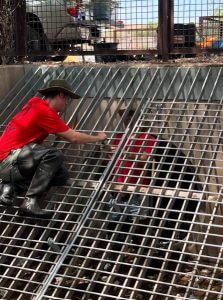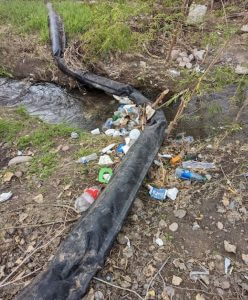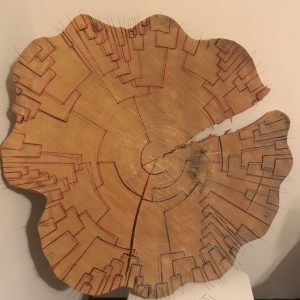Luke Ramsey
Tempe, Arizona
Luke Ramsey is an ecologist, artist, and educator based in Tempe, AZ, where he studies urban wetlands along the Salt River as part of Arizona State University’s Central Arizona-Phoenix Long Term Ecological Research Program (CAP LTER). Luke also works for ASU’s Vascular Plant Herbarium as well as Osprey Initiative LLC, an environmental solutions contractor that collaborates with City of Phoenix on litter mitigation efforts in the Rio Salado Habitat Restoration Area.
This interview was conducted by Carly Schmidt on February 7, 2023. Learn more about Luke’s work at https://osprey.world/.
What is Osprey Initiative and how did they get involved in litter capture work in Arizona?
Osprey Initiative is an environmental solutions contractor based out of Mobile, Alabama, and most of their operations are in the southeast. Arizona was a new direction for them not only because it’s so geographically far from the southeast but also because the ecosystem is so different. Here in Arizona, we get a lot less rain than Alabama or Louisiana. Instead of dealing with a perennial flow that’s consistent year-round, it’s really flashy. It still floods, but mainly during the monsoon seasons, while our rivers are dry most of the year. But Osprey really emphasizes experimentation. When there’s a problem, you just need to start trying things! Every system is different, and you never know what’s going to work, but surely what isn’t going to work is doing nothing. Make a design, get a group together, do what you can, and record the data on it. There’s always something to learn.
How did Osprey Initiative get involved with Rio Reimagined and can you explain how this partnership came to be?
Rio Reimagined is an initiative based out of Arizona State University (ASU) that is attempting to bring together different stakeholders and collaborators along the Salt River, which runs through the heart of the Phoenix area. This is a highly urbanized stream in a city of about 4.5 million people, if you include the nearby cities like Tempe and Mesa. The Salt River has been used and modified in every way you can imagine: dammed, diverted, restored, and ignored. Rio Reimagined is thinking about how we can look at a river system that is more connected ecologically but also socially with communities along the river. Osprey was brought in through a connection with River Network, as well as other partners, both for on-the-ground support and funding that makes the partnership possible.

And the last partner in this puzzle is the City of Phoenix. The area we’re working on at Osprey is the Rio Salado Habitat Restoration Area, which is a project that the City of Phoenix took on with the Army Corps of Engineers. The project was completed in 2006 to reclaim a former dumping ground. This part of the Salt River had become a place for people to chuck their old cars and appliances and garbage. All that debris had to be removed and groundwater was introduced. Groups in the community planted native vegetation too. Maintenance of this restoration area is a constant process of rehabilitation and, with all the litter coming out of storm drains, it is at risk of becoming a dumping ground again.
How are you addressing the ongoing issue of litter in the restoration area?

Osprey began a pilot project last summer. We started out with six months that we’re at the end of now. We basically said, “Hey, this is a completely different system than Osprey has worked in before. We’ll pull in some [litter capture] devices that have worked in other systems and design some new devices. We’ll implement them and monitor them through one heavy monsoon season and one light monsoon season and see what works and what doesn’t.” The hope is that this will inform some larger scale solutions that can be implemented across the watershed.
What have you learned about litter capture on the Salt River after these six months?
We picked three stormwater outfalls because this is where the majority of litter is coming in. At one of them, we placed a long net attached to the culverts. The second attempt is an improved version of grates, just metal bars over the culvert, but a lot of trash was slipping through the bars. We designed another with smaller openings, looking at some data to determine the average size to catch something like an aluminum can or a plastic water bottle. The third plan was a boom, a floating plastic tube that is anchored on either side of the wash and floats on the surface. When the stream is dry, the boom just sits on the ground, but when water comes through, it pushes the boom to the surface where it catches floating litter such as Styrofoam cups, plastic bottles, and aluminum cans. Stuff like vegetative litter and sediment can pass underneath the boom so it is not commingled with the aluminum or plastic we are attempting to recycle.
Will you continue to use all these capture devices on the Salt River?
The one that stood out as a failure was the net because of the complex social and ecological system we’re working in. If the net was still floating in water you could kind of coax the litter out and into a bin. But, since the area was dry for days at a time, it sat on the rocks, cooked in 110-degree heat, and became this sludgy mass where we couldn’t reclaim any recyclables. Another issue is that there is a large population of people that live in this area of Phoenix without shelter. They were using the water coming out of the outfall for bathing and other needs, so the net was repeatedly removed from the outfall.
The other two solutions worked great. The grate was the quickest to remove the litter from and captured the most weight. But it didn’t capture as much recycling that was reclaimable because of leaf litter and sediment getting mixed in. The boom caught less litter, but we were able to take more of it to recycling facilities. We think that the best solution is a hybrid of these two: a boom upstream of the grate to catch reclaimable litter and a grate to capture branches, plastic bags, blankets, and other heavy litter items.
You’re talking about the importance of ongoing maintenance, which takes consistent effort on the part of groups and volunteers. How do you keep people coming out to the river to help with these capture devices?
It goes back to partnerships. Building a support network of groups like the City of Phoenix, folks from River Network and ASU is important. Even if it is a small recurring team, they can do as much in the long term as a large team in one push. Also, being on our outreach game is very important. That’s where we lean on relationships through Rio Reimagined and River Network to bring new people in.
Before coming to grad school at ASU, I worked for six years in environmental education. It’s helpful to tap into that mindset to work with high school groups and scouting groups. It’s an interesting way not only to have help with the work but also to build knowledge of these systems and connection to them for the future. It’s exciting when kids realize that they can make a difference and start thinking about the careers they want to have in that lane.
How does education play a role in litter mitigation in the communities you work in? Do you see litter as a behavior change issue or more of a population density issue?
We think a lot about the sources. Personally, I’m surprised that the anti-litter campaigns of the last few decades haven’t reached everyone. I’ve been standing in one of our washes as someone threw trash down from the bridge above us. I’m not sure if the message hasn’t gotten through or if people are just not hearing it.
There are parts of Osprey’s work that go beyond picking up trash and are related to how we collect data. We’re not just removing debris and litter, we’re documenting the kinds of materials we’re pulling out, the brands, the condition, and the quantity. We can take this representative sample and determine what is coming into the watershed.
When you look at the volume, you get a clear picture of what all this trash is made from, and it’s mostly plastic. About 62% of all the litter we’ve collected has been plastic, and one third of that is plastic water bottles. So some of the biggest changes we could make involve shifts in materials manufacturing as well as behavior. For instance, we don’t see much paper turning up in the river, it breaks down faster for better or worse. So, we should be shifting away from plastic and Styrofoam to aluminum, glass, and paper. We also see which brands are contributing the most volume. In the summer, Circle K Polar Pops cups were showing up in the hundreds and, no surprise, there are a few Circle Ks in the vicinity of our site. But it gives us an opportunity to reach out to Circle K and move that behavior change and accountability to the source. Osprey partners a lot with Coca-Cola in these kinds of joint efforts to tackle waste in waterways.
You’re an artist and environmental educator as well. What is your take on the intersection of art and environmental science?

Truncated (2016): The phylogenetic tree of life, burned on to a cross section of a 96 year old oak tree downed in an abnormal straight line wind event in Memphis, TN. Both the diagrammatic tree and physical tree are split into two pieces, which represent the number of extinctions documented that year (red) and the number of species discovered or modified (blue).
There’s a lot of overlap between science and art in that they’re both about experimentation, observation, and trying to reveal things in new ways. I went into art in undergraduate school with a focus on using art to communicate trends in human-environment relations. Looking at things like climate change and mass extinction, I would try to visualize those trends through printmaking and sculpture. That’s how I started working in science communication and education. After undergrad, I went to work at the Museum of Science and History in my hometown of Memphis, TN, where I helped design exhibits and education materials, so I was both teaching and doing a bit of art and design on the back end. I got to work with curators and collection specialists as well as researchers and realized that I was really interested in urban river ecosystems but I didn’t have a lot of experience in ecological research myself so, if I wanted to communicate this scientific research well, I needed to go back to school. That’s how I ended up at ASU in the School of Sustainability studying the Salt River. ASU really emphasizes being interdisciplinary, so I’m able to work art into my thesis by making paper from the most common plants in my research sites and using this paper to visualize my data.








